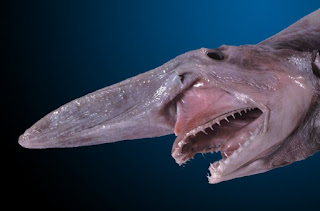Top 5 Mysterious Sea Creatures In Hindi || सबसे रहस्यमय 5 समुद्री जीव (हिंदी में )
Top 5 Mysterious Sea Creatures In Hindi
#Ajeeb_Duniya
Subscribe Our Channel::- http://bit.ly/ajeebduniya
Watch Video On YouTube
The blobfish
The blobfish (Psychrolutes marcidus) is a deep sea fish of the family Psychrolutidae. It inhabits the deep waters off the coasts of mainland Australia and Tasmania, as well as the waters of New Zealand.Blobfish are typically shorter than 30 cm (12 in). They live at depths between 600 and 1,200 m (2,000 and 3,900 ft) where the pressure is 60 to 120 times as great as at sea level, which would likely make gas bladders inefficient for maintaining buoyancy.Instead, the flesh of the blobfish is primarily a gelatinous mass with a density slightly less than water; this allows the fish to float above the sea floor without expending energy on swimming. Its relative lack of muscle is not a disadvantage as it primarily swallows edible matter that floats in front of it such as deep-ocean crustaceans.
Subscribe Our Channel::- http://bit.ly/ajeebduniya
Watch Video On YouTube
The blobfish
The blobfish (Psychrolutes marcidus) is a deep sea fish of the family Psychrolutidae. It inhabits the deep waters off the coasts of mainland Australia and Tasmania, as well as the waters of New Zealand.Blobfish are typically shorter than 30 cm (12 in). They live at depths between 600 and 1,200 m (2,000 and 3,900 ft) where the pressure is 60 to 120 times as great as at sea level, which would likely make gas bladders inefficient for maintaining buoyancy.Instead, the flesh of the blobfish is primarily a gelatinous mass with a density slightly less than water; this allows the fish to float above the sea floor without expending energy on swimming. Its relative lack of muscle is not a disadvantage as it primarily swallows edible matter that floats in front of it such as deep-ocean crustaceans.
The vampire squid can reach a maximum total length around 30 cm (1 ft). Its 15-cm (6-in) gelatinous body varies in colour from velvety jet-black to pale reddish, depending on location and lighting conditions. A webbing of skin connects its eight arms, each lined with rows of fleshy spines or cirri; the inner side of this "cloak" is black. Only the distal halves (farthest from the body) of the arms have suckers. Its limpid, globular eyes, which appear red or blue, depending on lighting, are proportionately the largest in the animal kingdom at 2.5 cm (1 in) in diameter.The name of the animal was inspired by its dark colour, cloak-like webbing, and red eyes, rather than habit—it feeds on detritus, not blood
Goblin Shark
The goblin shark is a rare species of deep-sea shark. Sometimes called a "living fossil", it is the only extant representative of the family Mitsukurinidae, a lineage some 125 million years old. This pink-skinned animal has a distinctive profile with an elongated, flattened snout, and highly protrusible jaws containing prominent nail-like teeth. It is usually between 3 and 4 m (10 and 13 ft) long when mature, though it can grow considerably larger. Goblin sharks inhabit upper continental slopes, submarine canyons, and seamounts throughout the world at depths greater than 100 m (330 ft), with adults found deeper than juveniles.
Sea Pigs
1,500 species of sea cucumbers, or holothurians, can be found in all oceans and at all depths, in a great variety of habitats – some burrow deep into mud or sand, while others may spend their entire lives swimming in midwater. It is in the dark reaches of the deep sea where the sea cucumbers rule. Here, a group known as the elasipods, of which Scotoplanes globosa is an example, can be found in enormous numbers
Barreleye Fish
Barreleyes, also known as spook fish (a name also applied to several species of chimaera), are small deep-sea argentiniform fish comprising the family Opisthoproctidae found in tropical-to-temperate waters of the Atlantic, Pacific, and Indian Oceans.These fish are named because of their barrel-shaped, tubular eyes, which are generally directed upwards to detect the silhouettes of available prey; however, according to Robison and Reisenbichler, these fish are capable of directing their eyes forward, as well. The family name Opisthoproctidae is derived from the Greek words opisthe ("behind") and proktos("anus").






No comments